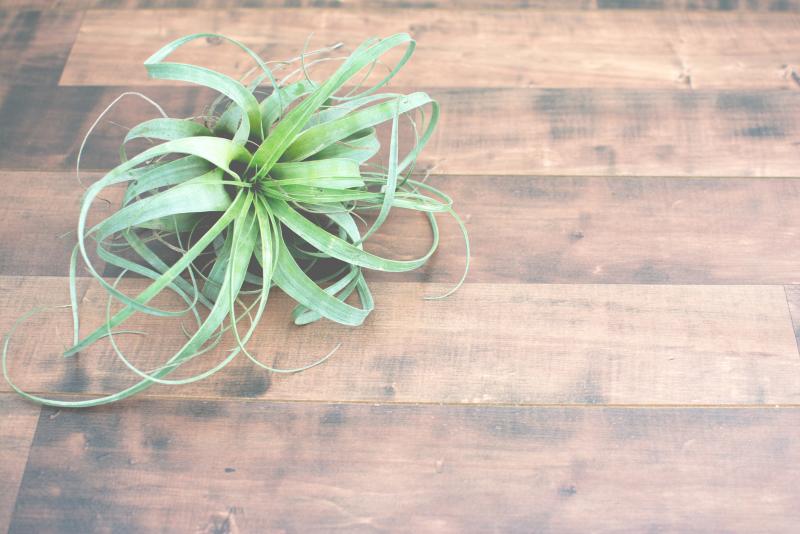Air plants… air what?
If you haven't heard about these unique plants then we need to fill you in on the houseplant that has been around for a while but is gaining ever popularity.
Most think of houseplants as floor or tabletop specimens with bright green, or possibly colorful foliage dressed with a functional decorative pot. That plant would be in a pot filled with soil for the purpose of supporting the plants upper growth. These plants would have been selected for their decorative or functional aspect of color, look, texture, and possibly for filling a space in the home or office.
Trending lately are plants which are the opposite of what we traditionally see for our homes. These trending plants maintain themselves without the necessity of growing in soil. They are plants with characteristics sometimes described as delicate, spiky, feathery, leathery, or curly, require very little space, and are used as an accent but on a tiny scale. These trending plants are known as Tillandsia or air plants.
Tillandsias belong to the largest genus in the bromeliad family native to warmer climates. Like orchids and trailing mosses, tillandsia fall under the "epiphyte" term whose main attribute is the limited, or absence of major roots. Roots that may be present are unique in character and habit as they do not require soil to maintain the plants structure or growth.

Some tillandsia species use some of their root systems to attach themselves to trees or rocks in their natural habitat; absorbing moisture and nutrients through their leaves. In their original habitat the moisture they required would be taken up from rain water that ran through the upper canopy of their host trees. Adding to their characteristics we find a wide range of sizing, from some small enough to fit in the palm of a hand to mature ones over a foot long. Most people seek the smaller ones, while others are drawn to the larger specimens. Though many tillandsias are in shades of green, many also have a tinge of grey, while some will have flair of peach tinge to rich burgundy red color to their leaves.

Our desire for something unique has made this plant even more popular with the artistic way in which this plant may be used and designed with. The root-less character of these plant types blend favorably with its knack to be placed uniquely and imaginatively. Depending on plant size of choice, tillandsias may be used in terrariums, nestled on rocks or placed into decorative hanging glass orbs. The tillandsias are adaptable and tolerant to a wide range of environmental conditions and require minimal care. The three most important requirements for proper care and growth for these plants are bright light — not direct sunlight; good air circulation and water.

Watering requirements differ from potted plants. Depending on thickness of the tillandsia's growth and texture, weekly or bi-weekly "dunking" in watering may be required. Dunking — referring either to running the tillandsia under a gentle stream of water, placing them in a container of water and letting them rest on the surface or sink into the water for a few minutes. After dunking these plants it is recommended to allow the plants to dry completely before the next watering time. Signs of insufficient watering will be evident with "curled" or "rolled" leaves. "Misting" these plants may be insufficient but may be done occasionally. Finer and delicate green leaf varieties may require a watering schedule of 2 - 4 times a week while grey or silver tone varieties prefer less moisture. Good ventilation will allow for the plants to dry perfectly after their scheduled watering aiding in the prevention of disease caused by overwatering. Light plays a factor with tillandsia. As most tillandsia in their natural habitat adhere roots to host trees or some rocks where there is an upper canopy of leaves, we take clue that they would benefit from bright light — not direct sunlight.

Do tillandsia plants flower? Yes they do. Like most tropical plants; given the proper conditions — they will bloom. The blooms are diverse and colorful varying in size and color. Colors span from yellow, orange, red, purple, blue and whites.
These plants will add a touch of greenery and individuality to a small space. They can be utilized to create table centerpieces. Mounting them singly or as a collection to driftwood pieces, decorative picture frames or rocks is an option. Another simple design is to lay them onto simple or decorative bowls with a base of colorful moss or decorative stone; either natural or colorful. Placing them into suspended glass orbs is also trending. Glass orbs either small or large; create a statement by placing a decorative base. Add a whimsical fairy garden piece as an accent or possibly a battery operated tealight to give your glass orb a glowing accent to your tillandsias. Are you ready for plants — with roots without soil? Are you ready for the venture into tillandsias?
St. Mary's Nursery carries a diverse selection of Tillandsia every spring.








